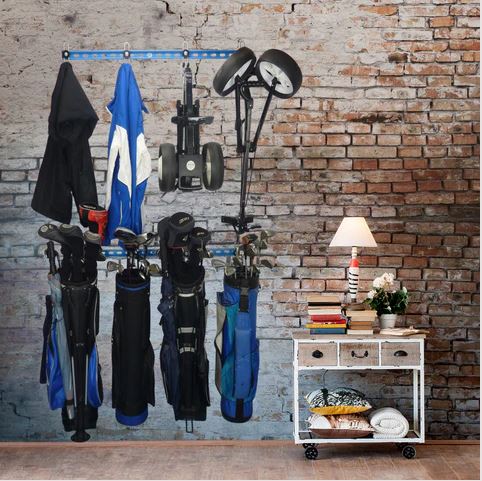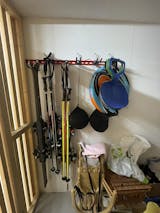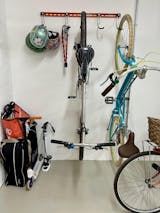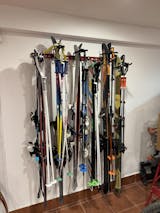
Advice for Storing Your Golf Equipment Without Damaging It
Share
Golf clubs, bags, and accessories are significant investments, and without appropriate care, they can quickly become damaged or deteriorate.

Photo by Nadim Shaikh: https://www.pexels.com/photo/golf-equipment-on-grassy-field-7758346/
Ensuring that your equipment is stored correctly can help you avoid common issues such as rust, warping, and mould, which can negatively impact your performance on the course.
Cleaning and Maintenance Before Storage
Before storing your golf equipment, it's crucial to clean it thoroughly:
- Clubs: Use a soft-bristle brush and mild soap to clean the clubheads, paying particular attention to the grooves. Wipe down the shafts with a damp cloth and dry them completely to prevent rust.
- Bags: Empty your golf bag and shake out any debris. Use a vacuum to remove dirt from the pockets. Spot clean the fabric with a mild detergent and a soft cloth, and ensure the bag is completely dry before storage.
- Accessories: Clean golf balls, tees, gloves, and other accessories with appropriate methods. For example, wipe gloves with a damp cloth and allow them to air dry. Clean golf balls with soap and water, and dry them thoroughly.
And remember! Moisture is one of the biggest enemies of golf equipment. After cleaning, ensure that all components are completely dry before storage.

Photo by sydney Rae on Unsplash
Moisture can lead to rust on metal parts, mould and mildew on fabric, and general deterioration of materials. Use a towel to dry your equipment and leave it in a well-ventilated area to air dry fully before storing.
Optimal Storage Conditions
Proper storage conditions are crucial for preserving the quality and longevity of your golf equipment, ensuring it remains in top condition for your next game.
Ideal Temperature and Humidity Levels
Golf equipment should be stored in a controlled environment to prevent damage. Ideal storage conditions include:
- Temperature: Keep your equipment in a cool, dry place. Avoid storing it in areas that experience extreme temperature fluctuations, such as garages or attics. The optimal temperature range is between 50°F and 70°F (10°C to 21°C).
- Humidity: Maintain low humidity levels to prevent rust and mould. A relative humidity level of 30% to 50% is ideal. Use a dehumidifier in damp areas to control moisture levels.
Avoiding Direct Sunlight and Moisture
Exposure to direct sunlight can cause fading and deterioration of materials, while moisture can lead to rust and mold. Store your golf equipment away from windows and in a dry location. Consider using protective covers for your clubs and bags to shield them from dust and light.
Using Golf Bag Organizers
Golf bag organizers are essential for maintaining order and protecting your equipment and have many benefits:
- Organization: Keep your clubs, balls, and accessories neatly arranged, making it easier to find what you need quickly.
- Protection: Prevents damage by keeping items separated and secure, reducing the risk of scratches and dings.
- Space Efficiency: Helps utilize space more effectively, especially in limited areas like garages or small storage rooms.
- Accessibility: Makes it convenient to grab your gear and go, ensuring that everything is in its place and ready for your next round.
Some of the best golf organizers in the market at the moment include:
GearHooks Golf Club Bag Organiser Rack : A cost effective wall mounted rack that will hold up to 5 golf bags or trolleys in just 1M of wall space. Galvanised and powder coated.
Milliard Golf Organizer: A highly rated standalone option with adjustable shelves and a sturdy metal frame, perfect for storing multiple bags and accessories.
Suncast Golf Organizer: Known for its durability and ample storage space, this standalone unit includes racks for two bags and additional storage for balls, shoes, and other gear.
SafeRacks Wall-Mounted Golf Organizer: This wall-mounted unit is praised for its heavy-duty construction and ability to hold up to two golf bags, clubs, and various accessories.
Mythinglogic Golf Storage Garage Organizer: A versatile combination unit with a rack for golf bags, shelves for accessories, and hooks for miscellaneous items.
Storing Golf Clubs
When storing golf clubs, proper positioning is crucial to avoid damage:
- Vertical Storage: Store clubs in an upright position to prevent bending or warping. Use a golf bag organizer or a stand to keep them secure.
- Avoid Pressure: Ensure that clubs are not leaning against hard surfaces or each other, which can cause dents and scratches.
- Spaced Out: Give each club enough space to avoid contact with others, minimizing the risk of damage.

Photo by Jopwell: https://www.pexels.com/photo/man-standing-beside-man-holding-gray-club-1325735/
Headcovers are essential for protecting the heads of your golf clubs from scratches and dings. Use them for:
- Protection: Prevents damage to the club heads during storage and transport.
- Longevity: Helps maintain the condition of your clubs, extending their lifespan.
- Identification: Many headcovers are designed to help you quickly identify each club.
Storing Golf Bags
Storing your golf bag upright is the best way to maintain its shape and protect the contents. It also helps if you:
- Use an Organizer: Place your bag in a golf bag organizer or a dedicated storage space to keep it upright and stable.
- Avoid Leaning: Do not lean your bag against walls or other surfaces, as this can cause it to tip over and damage the clubs inside.
Protecting Bags from Dirt and Dust
To keep your golf bag clean and in good condition, consider the following:
- Cover the Bag: Use a dust cover or an old towel to protect your bag from dirt and dust.
- Store in a Clean Area: Keep your bag in a clean, dry area away from direct sunlight and moisture.
- Regular Cleaning: Periodically clean your bag with a mild detergent and a soft cloth to remove dirt and grime.
Storing Golf Balls and Accessories
Proper storage of golf balls ensures they remain in optimal condition for your next round. Make sure you follow these tips:
- Cool and Dry Location: Store golf balls in a cool, dry place to prevent them from becoming brittle or losing their elasticity. Avoid areas with high humidity or extreme temperatures.
- Avoid Direct Sunlight: Exposure to direct sunlight can degrade the material of the golf balls, affecting their performance.
- Use a Container: Keep golf balls in a container or a designated drawer to protect them from dust and damage. Ensure the container is clean and dry.

Photo by Matthew LeJune on Unsplash
Keeping your accessories organized can save you time and extend the life of your gear.
- Tees: Store tees in a small container or bag to keep them together and prevent them from getting lost.
- Gloves: Keep golf gloves flat and dry. Store them in a glove compartment or a breathable bag to maintain their shape and prevent them from getting stiff.
- Other Accessories: Use small compartments or organizers for items like ball markers, divot tools, and scorecards. This keeps everything in one place and easy to find.
Endnote
Proper storage of your golf equipment is essential for maintaining its condition and ensuring it performs well when you need it. Following these guidelines, you can enjoy your investment for years to come and always be ready for your next round on the course.









